The Ivory Coast is a nation with a rich footballing heritage and has produced a plethora of talented players who have each left their mark on the global stage. One such luminary is Didier Drogba. The legendary striker’s physical prowess, clinical finishing, and leadership qualities made him an iconic figure in the football world. Drogba played a pivotal role in Chelsea’s success during his time with the club, helping secure the Premier League title on four occasions and the UEFA Champions League.
Another prominent figure from the Ivory Coast is Yaya Touré, who, of course, enjoyed immense success with Manchester City and Barcelona. Additionally, he captained the national team to their 2015 African Cup of Nations win.
When we talk about football in Ivory Coast, we have to mention ASEC Mimosas – the highly prominent club based in Abidjan. The club was founded in 1948 and has since become one of the continent’s most successful and widely recognised football institutions. Known for its distinctive yellow and black colours, ASEC Mimosas has consistently been a powerhouse in Ivorian and African football.
Most famously, the aforementioned Yaya and his brother, Kolo Touré, spent their youth careers with ASEC before moving to Europe. Gervinho and Emmanuel Eboué are two players who have also donned the iconic shirt of the 29-time Ligue 1 champions.
In this tactical analysis and scout report, we will use EYEBALL to identify some of the most exciting prospects in the ASEC Mimosas youth system. We will highlight how they fit into the tactics of the youth teams and showcase what makes them such promising young players.
Mohamed Abdul Kader Kone
The first player we will look at in this analysis piece is U20 central midfielder Mohamed Abdul Kader Kone. The 16-year-old has put in some impressive performances and has been unfazed by the step up from U17 to U20 level.
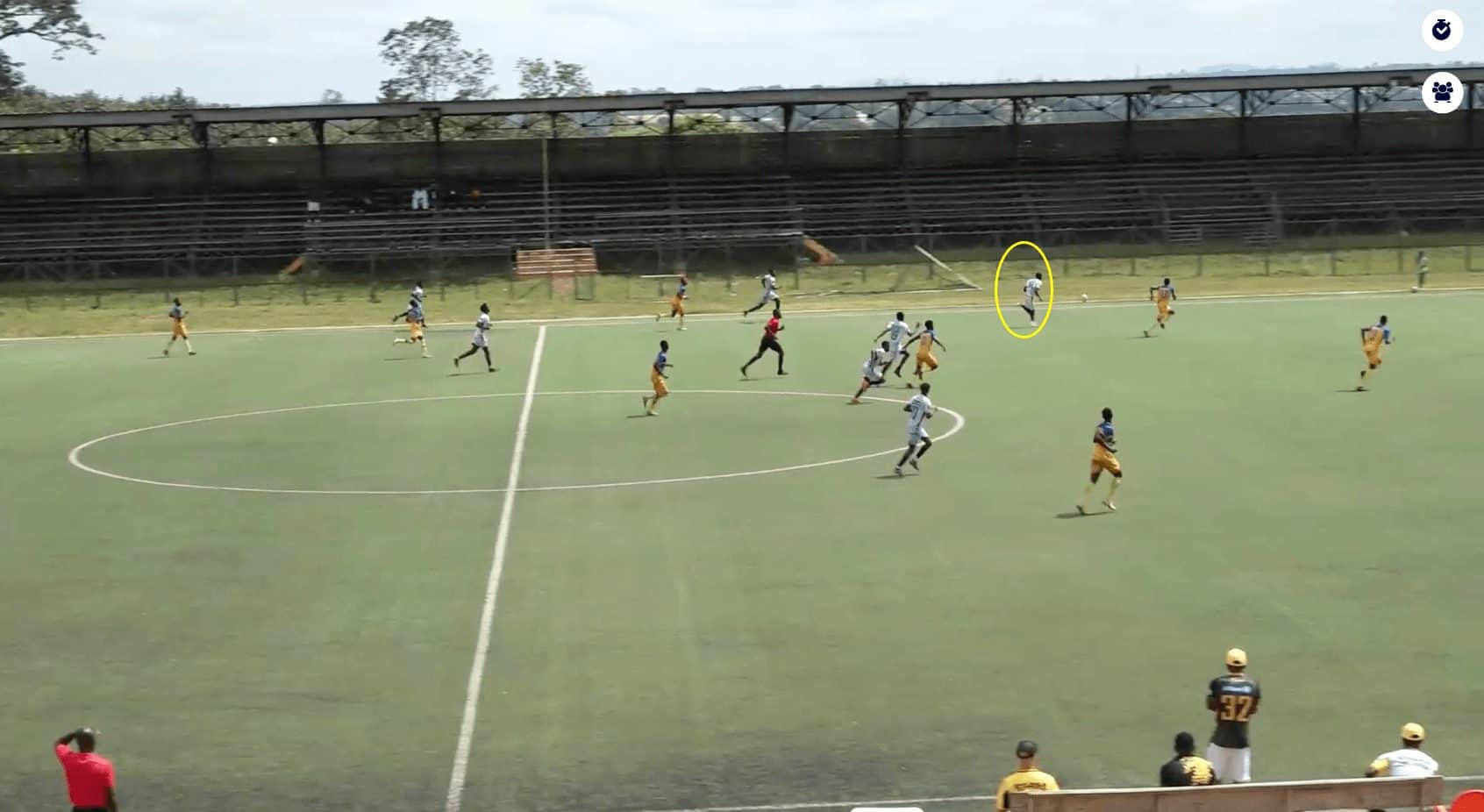
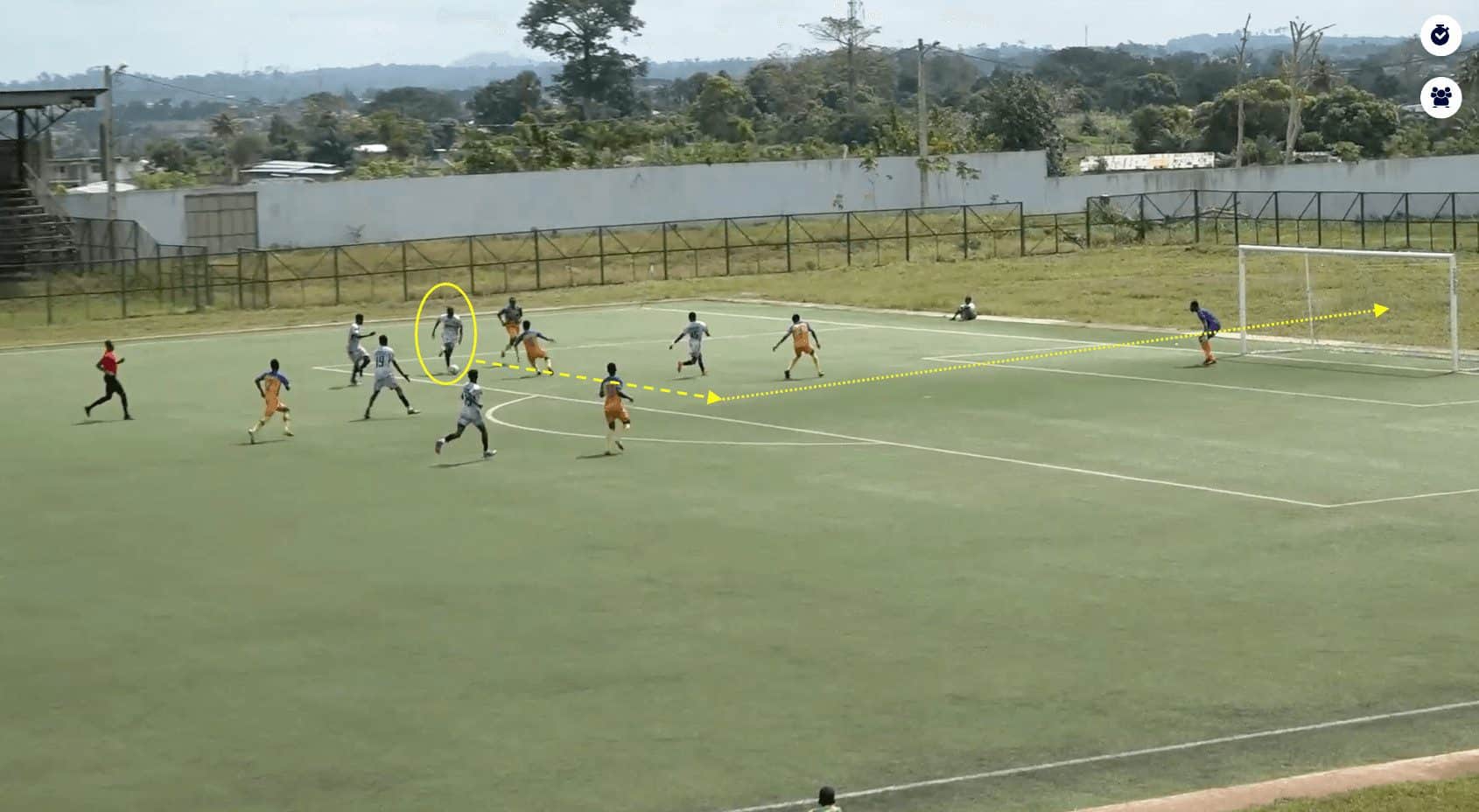
Kone is a central midfielder who is very intelligent in his movements and ball-carrying ability. He loves to drift into half-spaces and wide areas to receive the ball. This adds an element of surprise to ASEC Mimosas U20’s attacking play. Kone’s ability to drift into wider areas to pick up possession forces the opposing defenders to adjust their positions, creating spaces and openings in the middle for other attacking players to exploit.
By drawing defenders out of position as they track Kone, spaces emerge in the middle of the pitch. This means ASEC Mimosas can utilise more intricate passing sequences and facilitate a smoother transition from defence to attack. Additionally, as we can see in the example above, Kone likes to cut in from the left and unleash powerful shots with his right foot.
The young midfielder averages 2.5 shots per 90 with an average of 1.23 on target per 90. He is also very adept at taking on opponents and possesses very quick feet. Coupled with his rapid acceleration, it can be difficult for the opposition to successfully prevent him from progressing the play. Kone averages 2.3 take-ons per 90, often integral to Mimosas’ counterattacking play.
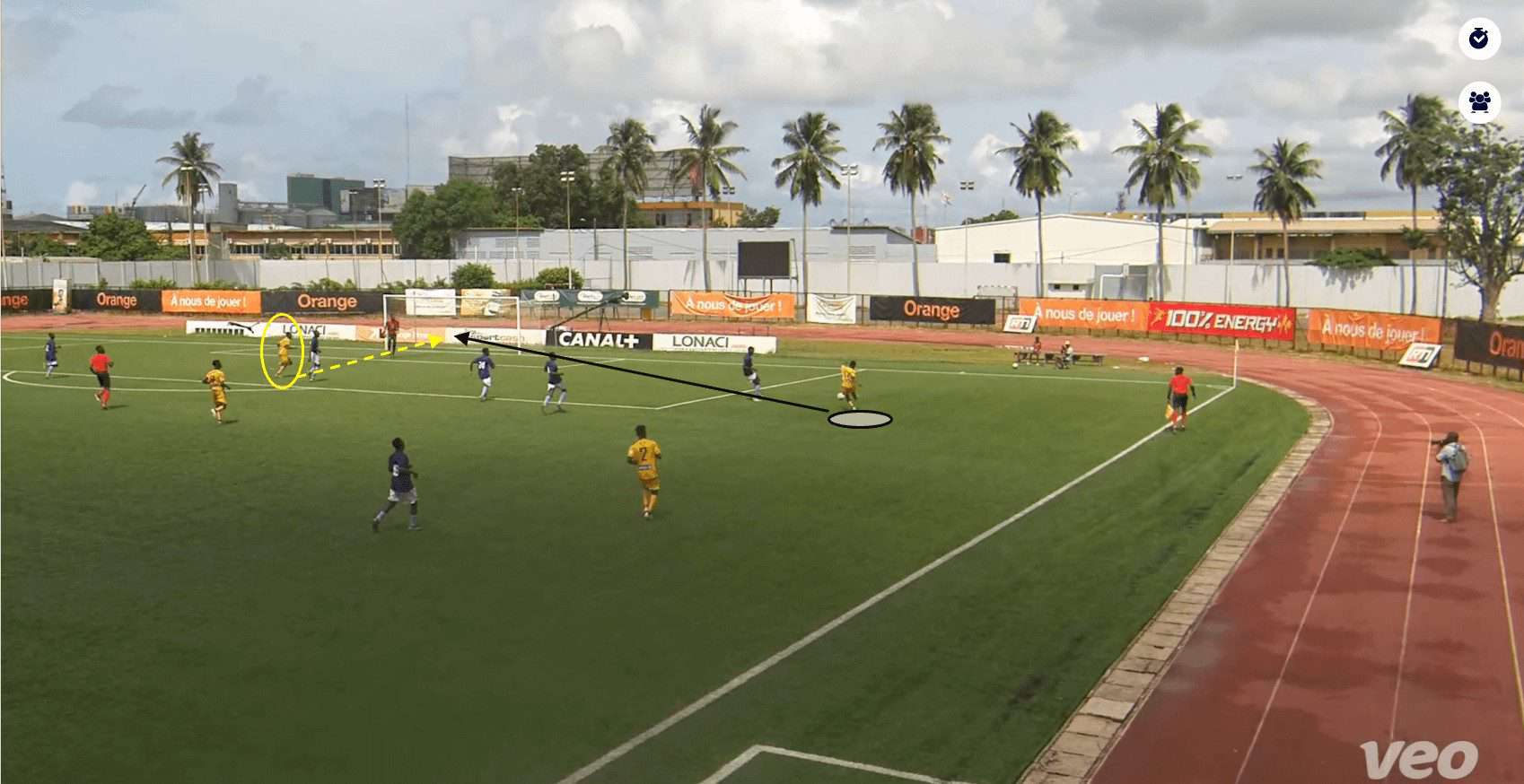
Moreover, Kone makes plenty of intelligent runs into the box from central areas, mostly looking to turn crosses goalwards. In this example, he sprints forward and is very tenacious, allowing him to reach the cross ahead of the defender.
Kone provides a reliable goalscoring threat. He has a natural attacking instinct, which sees him time these runs forward. He can also shoot with either foot and has a very good jumping reach when heading the ball, making him an excellent target for incoming crosses. His proactive approach from the midfield position can undoubtedly be a game-changer, adding new dynamics to the team’s attacking play and creating problems for opposing defences to solve.
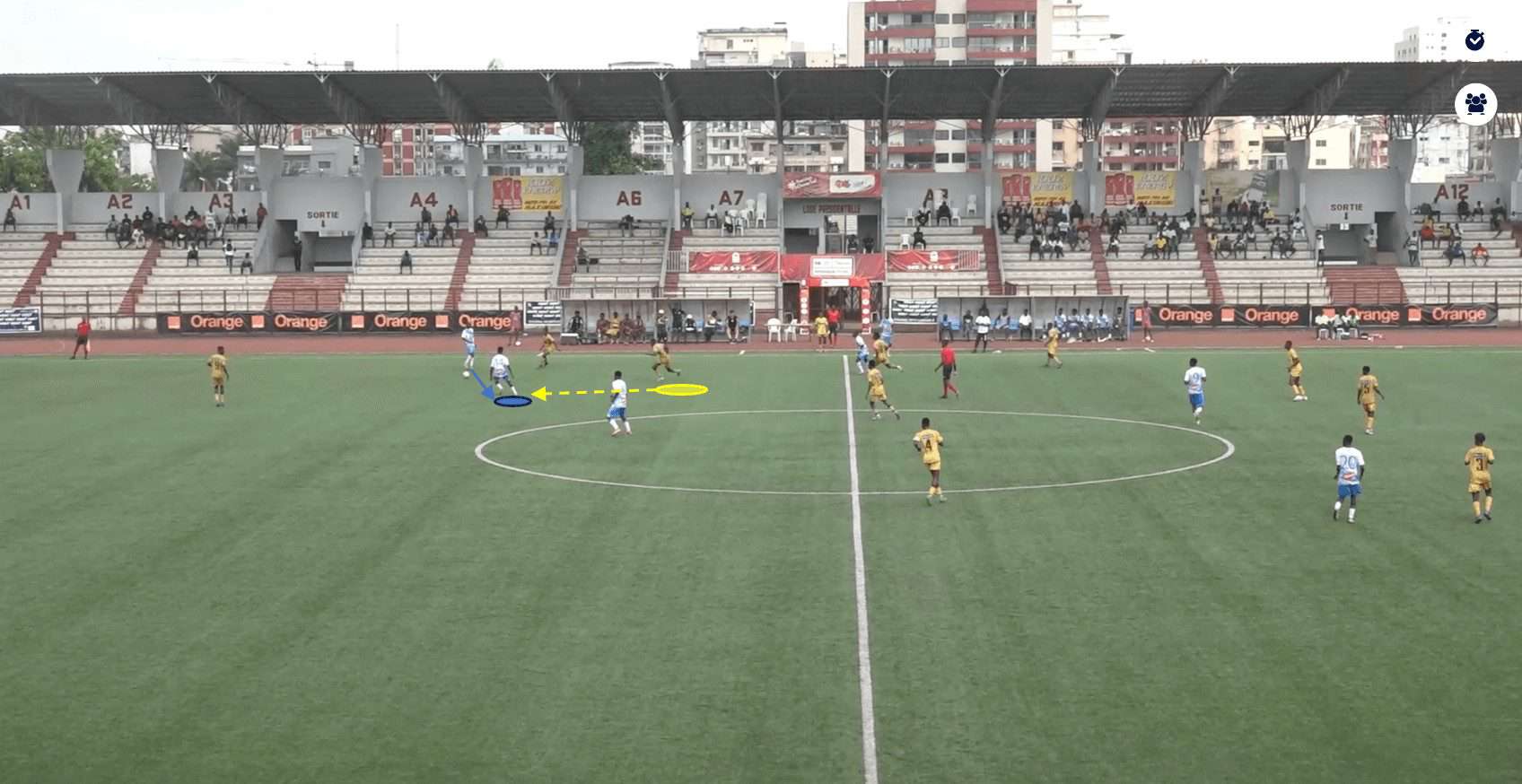
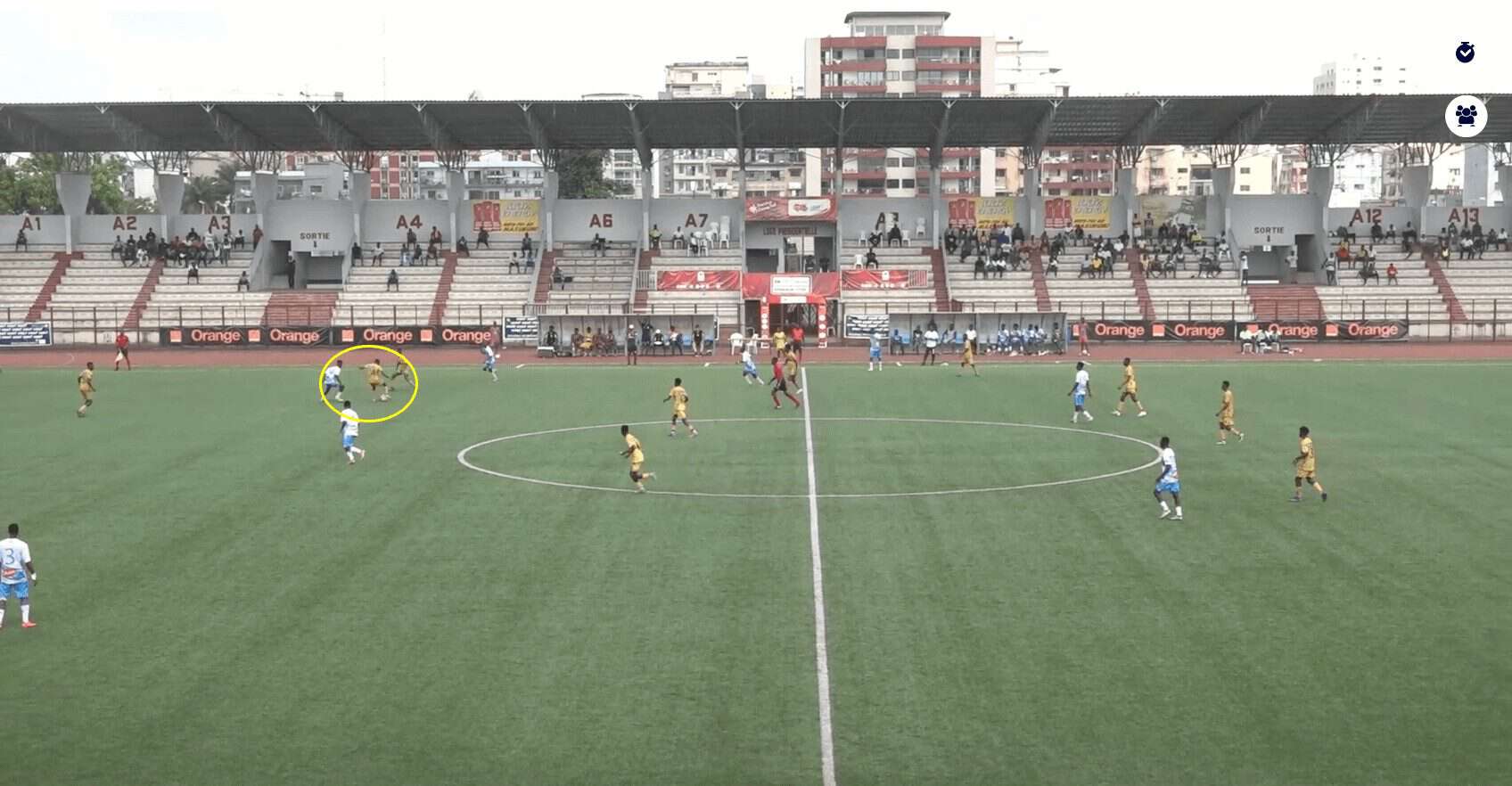
In terms of his defensive work, Kone is incredibly hard-working and exhibits a great ability to sustain ASEC Mimosas’ intense pressing tactics in the middle of the park. It is usually Kone’s responsibility to initiate the press as he can cover the ground rapidly. In this instance, as soon as the ball is played into the opposition midfielder, Kone springs into action. He puts the player under severe pressure, using his body to close off passing lanes and then ensure he gets a foot on the ball. The dynamic midfielder then gets his own body in between the player and the ball and wins a foul for his team.
He does not shy away from his defensive duties. Instead, Kone thrives in the duels, and consequently, he averages 1.76 aerial duels per 90 and 1.58 ground duels per 90. In addition, he is highly tenacious, and data shows he executes 4.6 ball recoveries per 90, which allows Mimosas to hit teams on the counter effectively.
Moïse Elohim Kaboré
The next player we are going to look at is 16-year-old striker Moïse Kaboré, who has recently broken into the first-team.
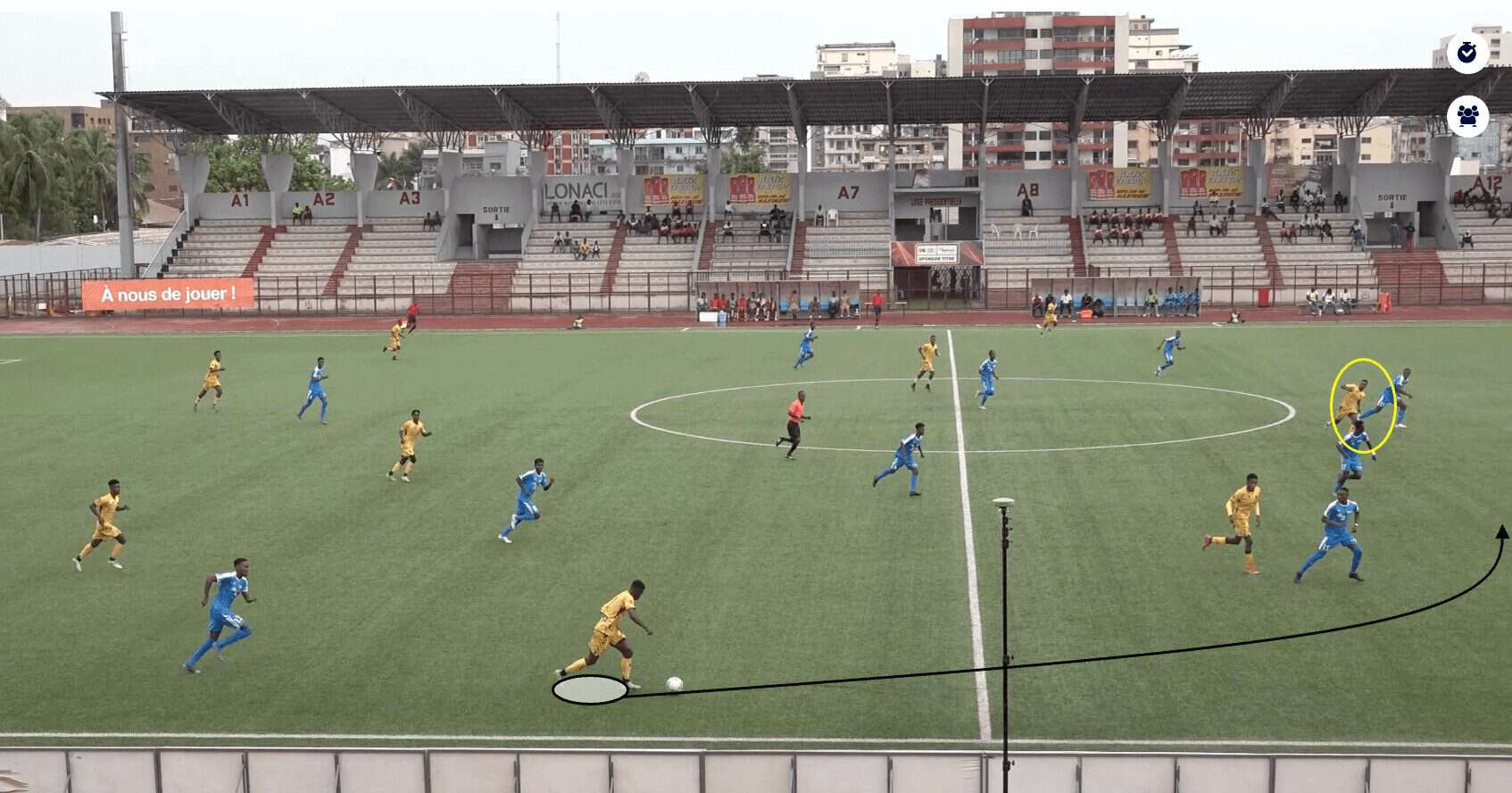
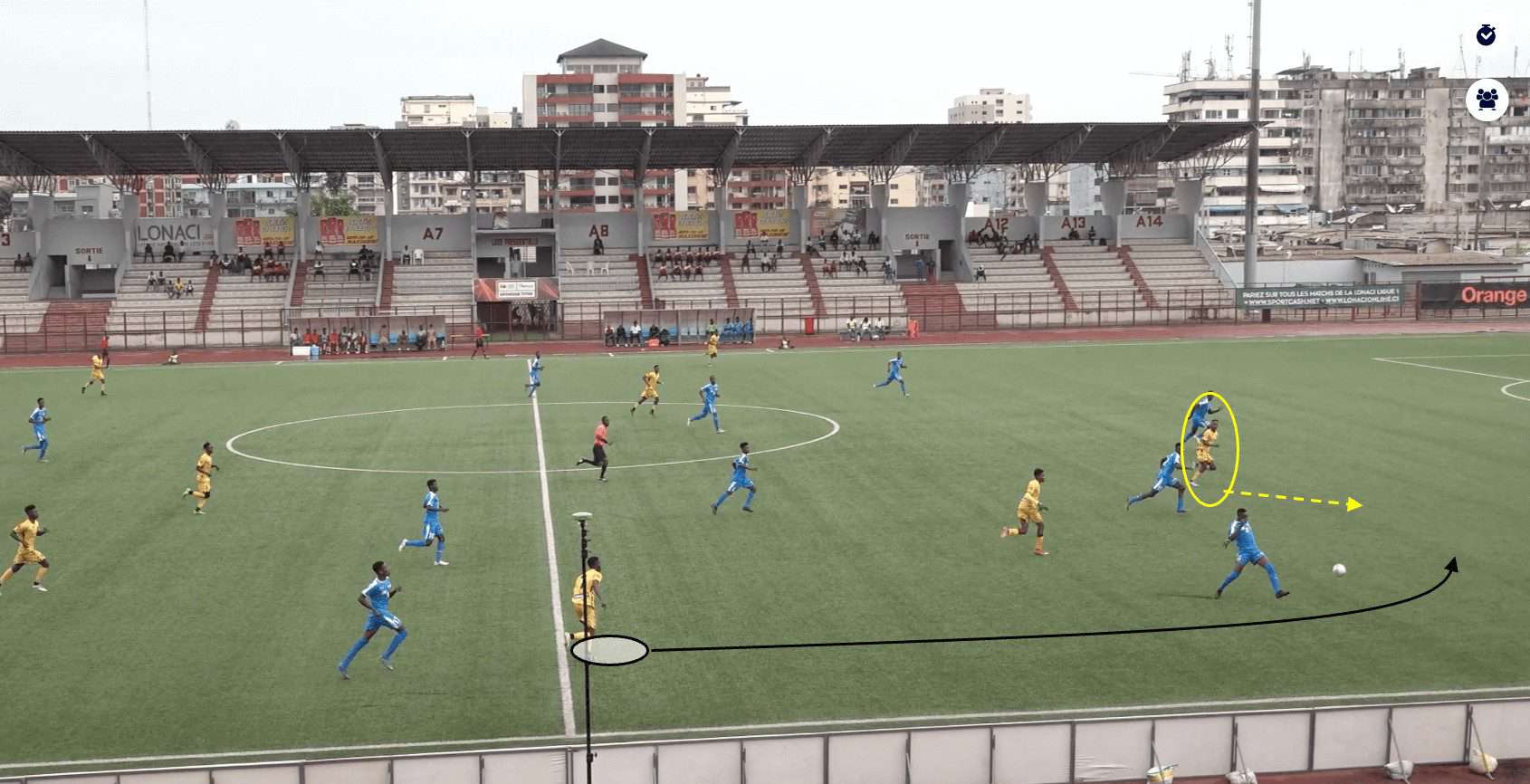
Kaboré is a forward who likes to make runs in behind the opposition’s defensive line. This is a great way to stretch the opponent’s backline, creating spaces in the defensive structure, as shown above. When Kaboré makes well-timed and intelligent runs, it forces defenders to track his movement, creating gaps in the defensive shape.
We can see how the opposition defenders are drawn to following Kaboré’s movement. This provides additional space for other attacking players, such as Kone, to exploit, thereby making it more challenging for defenders to maintain a compact and organised defensive block.
Furthermore, this also generates opportunities for through balls and direct passes from the midfield and fullbacks. Kaboré is a prime target for teammates looking to play incisive passes. This verticality in the team’s play not only breaks lines of defence but also allows for quicker transitions from defence to attack.
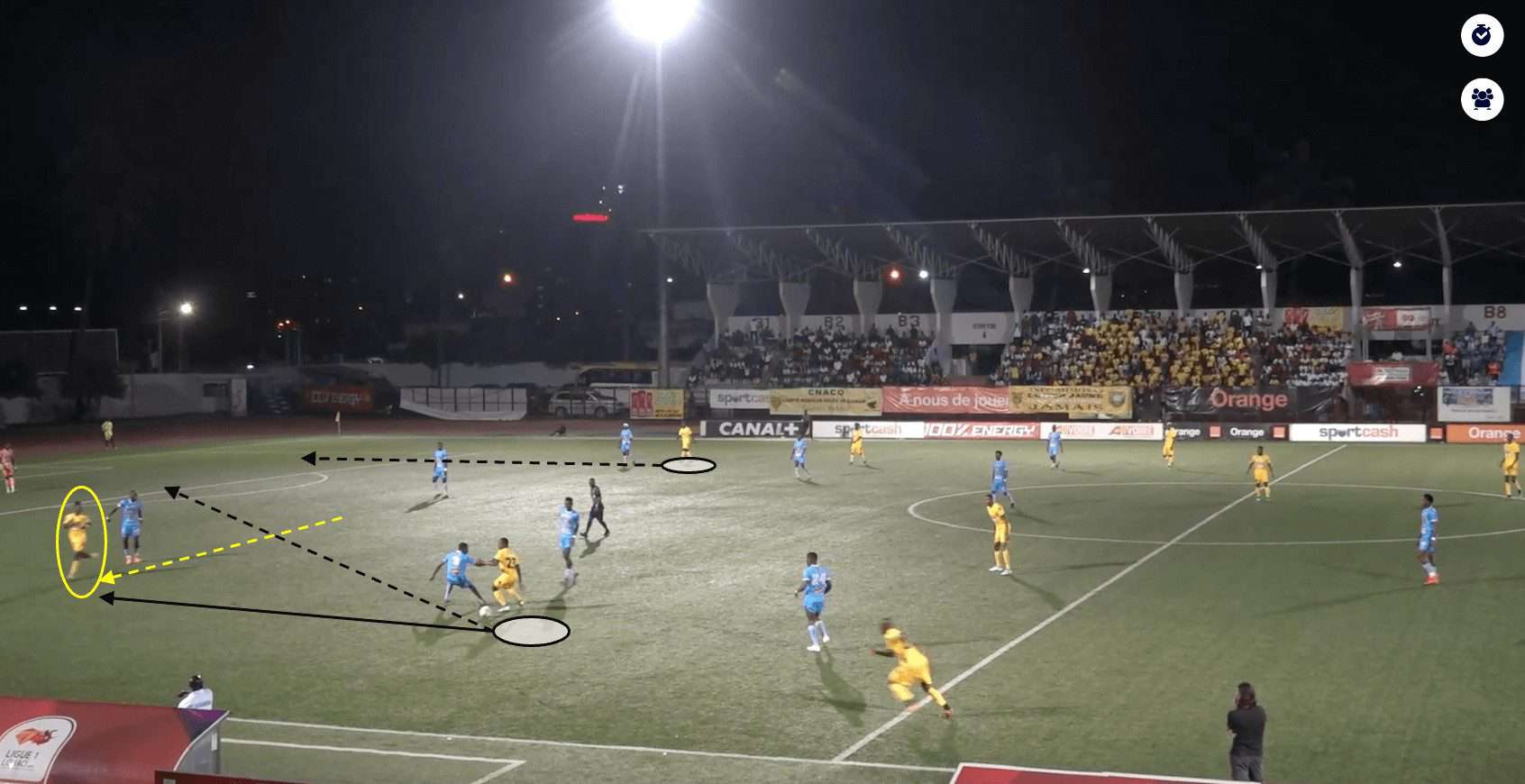
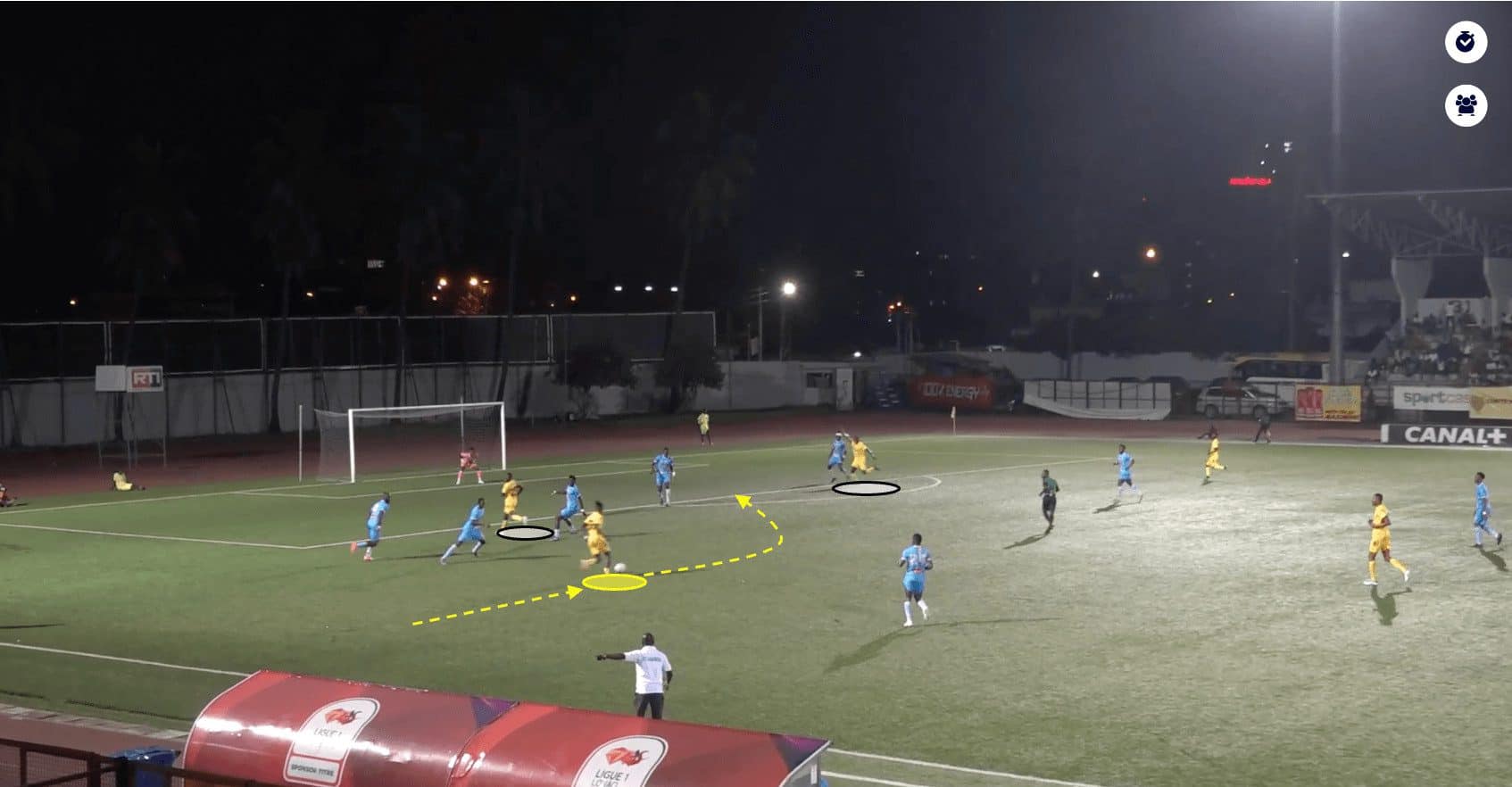
Kaboré likes to move into the half-spaces to receive the ball; he does this to draw the central defenders out of position and create space for midfield runners to get forward. In this instance, we can see that as the forward moves wider, the left midfielder can run into the penalty area after playing the ball, while the right midfielder also makes a run into the box. On this occasion, Kaboré opts to carry the ball into the open space ahead before unleashing a shot on target from the edge of the area.
Moreover, the intelligence runs from the midfielders into advanced positions, which means the defenders have to react and adjust their positioning. As a result, space opens up in front of Kaboré. Despite his young age, he is extremely confident with the ball at his feet. The ASEC Mimosas forward averages 3.4 shots per 90, and 3 per 90 are taken from inside the penalty area, which shows us that he aims not to be wasteful by hitting long-distance shots that are less likely to hit the target.
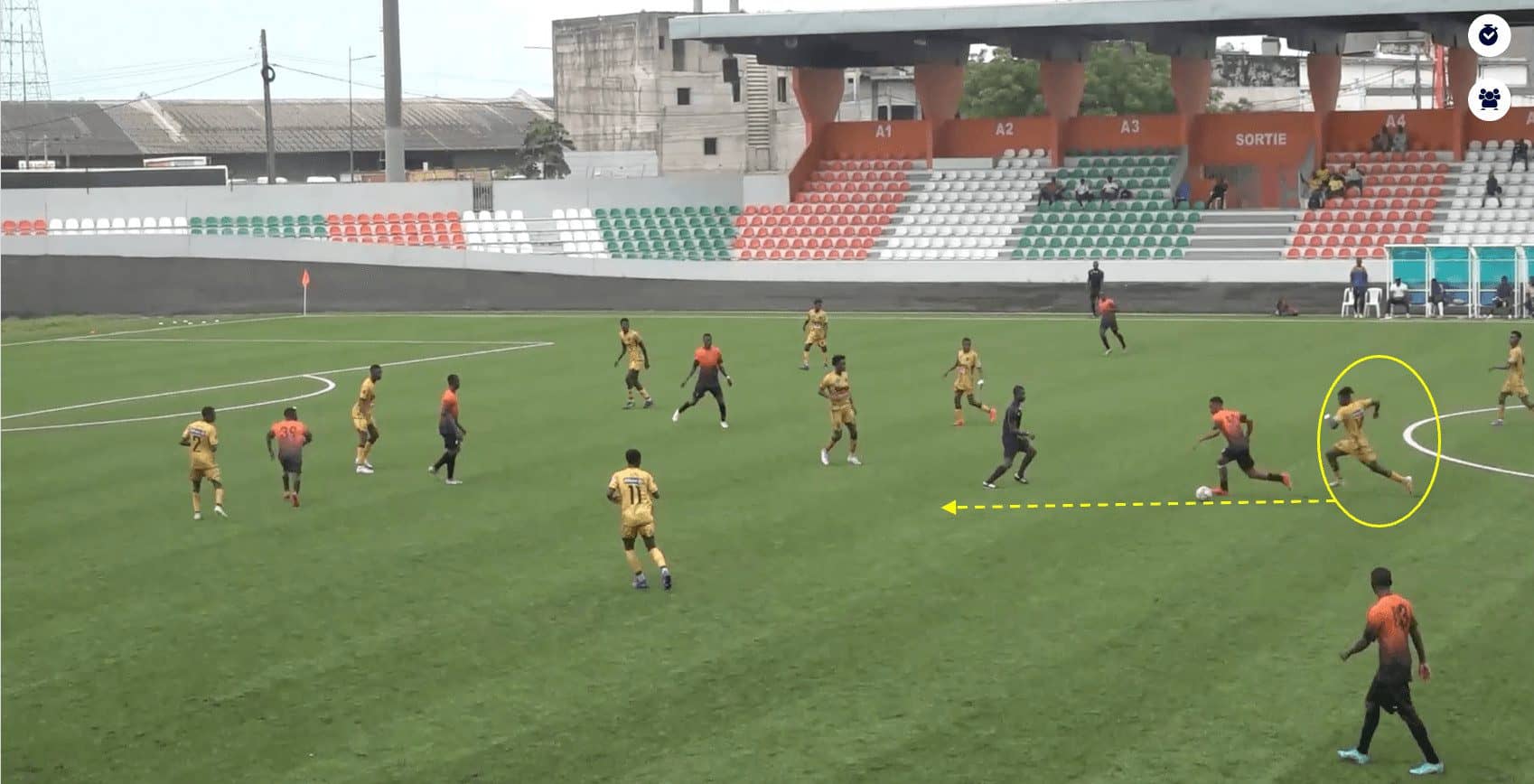
Out of possession, Mimosas U20s look to quickly transition to a compact defensive shape to limit the opposition’s opportunities to counterattack. Kaboré utilises his speed to get back into the defensive structure as soon as possible. By quickly regrouping and adopting his defensive positioning, he assists in closing down passing lanes, denying opponents space, and creating a cohesive defensive block.
His disciplined defensive approach can be instrumental in frustrating opposing attackers, limiting their options, and reducing the likelihood of his team conceding goals. Kaboré averages 0.95 tackles per 90 in addition to making 3 ball recoveries per 90, indicating he is willing to work hard defensively as ASEC Mimosas aim to recover possession.
Junior N’Cho
With Kaboré making the step up to playing in the first team semi-regularly, it has opened the door for 17-year-old centre forward Junior N’Cho to get some game time in the U20s.
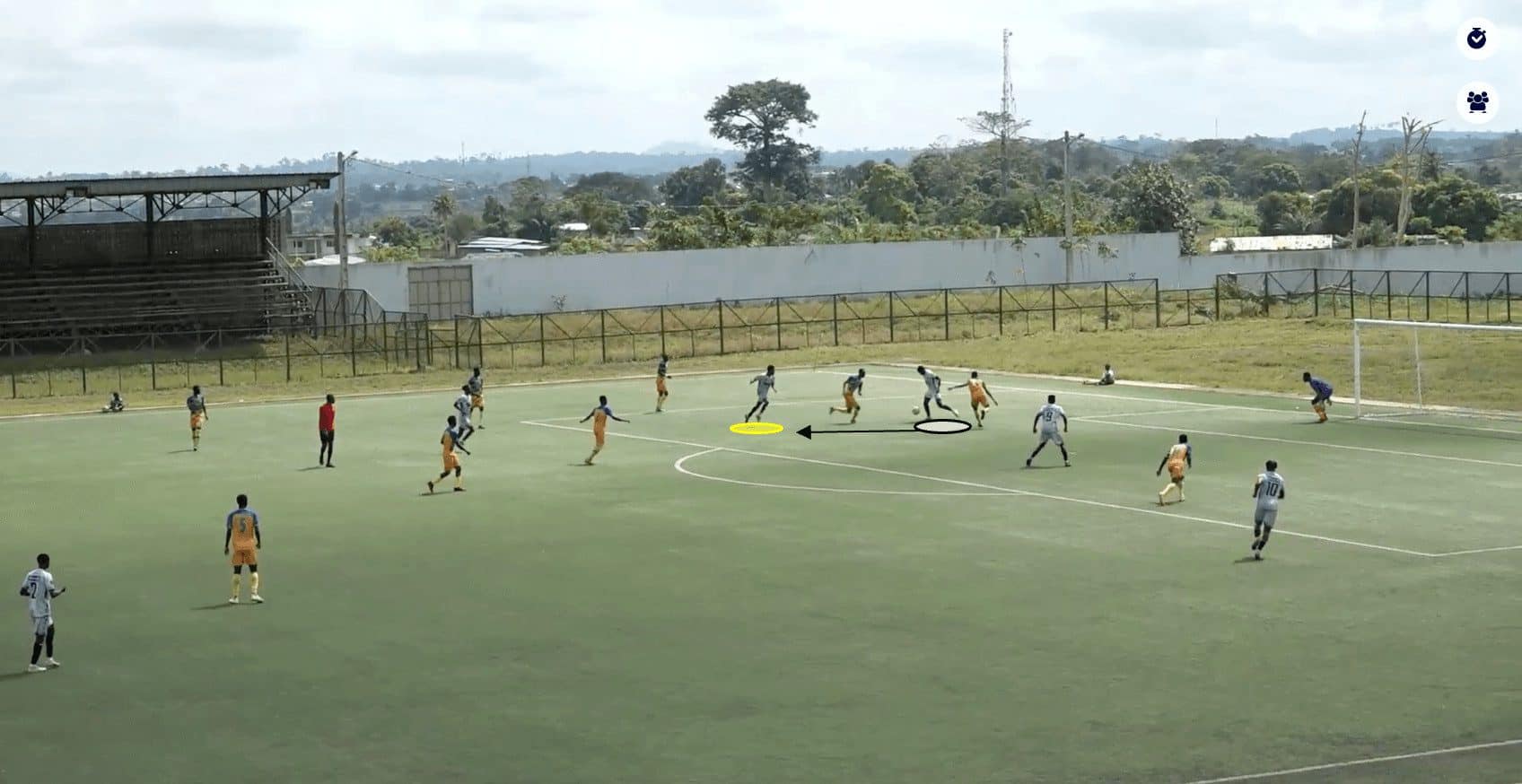
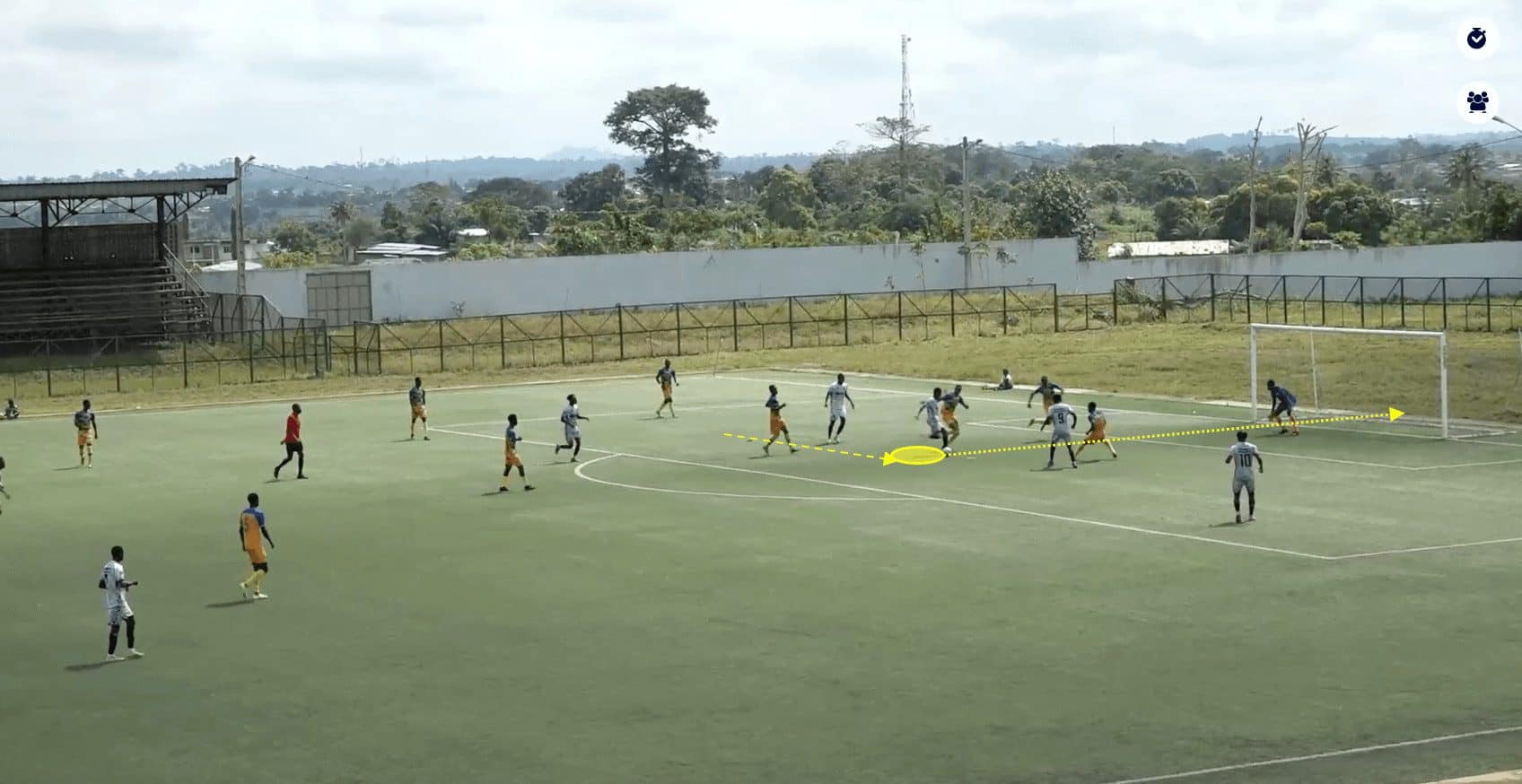
N’Cho is a striker who is very active in and around the opposition penalty area. He has excellent close control and quick feet, allowing him to manoeuvre the ball quickly beyond opposition defenders. In the example above, he receives the ball from a teammate and executes a short burst of acceleration to carry it away from opponents. Following this, N’Cho hits a powerful shot into the bottom corner.
The young forward’s agility and close ball control further enhance his ability to create space for himself in the box. By swiftly changing direction or executing sudden bursts of acceleration, N’Cho can create separation from defenders, opening up opportunities to take shots or exploit defensive vulnerabilities.
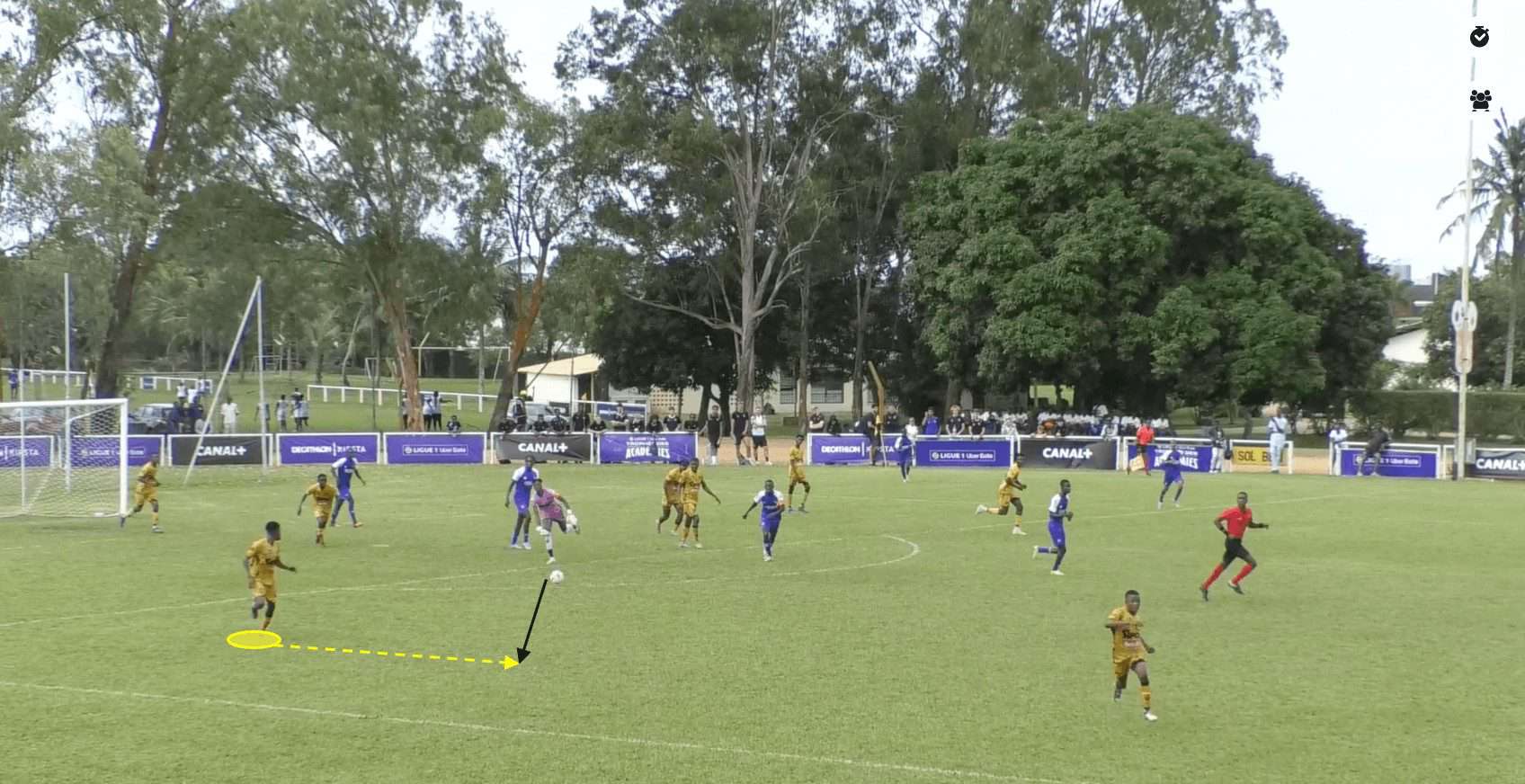
Additionally, N’Cho can carry the ball at speed, which adds a dynamic dimension to the team’s counterattacking prowess. We can see in this scenario the goalkeeper rolls it out to the pacy forward, who has the opportunity to use his speed and dribbling ability to hit the opposition on the counter.
N’Cho looks to exploit open spaces and sprint up the pitch with the ball, catching opponents off guard. This rapid transition catches the opposition out of their defensive organisation, allowing him to advance into dangerous areas before the defence can regroup.
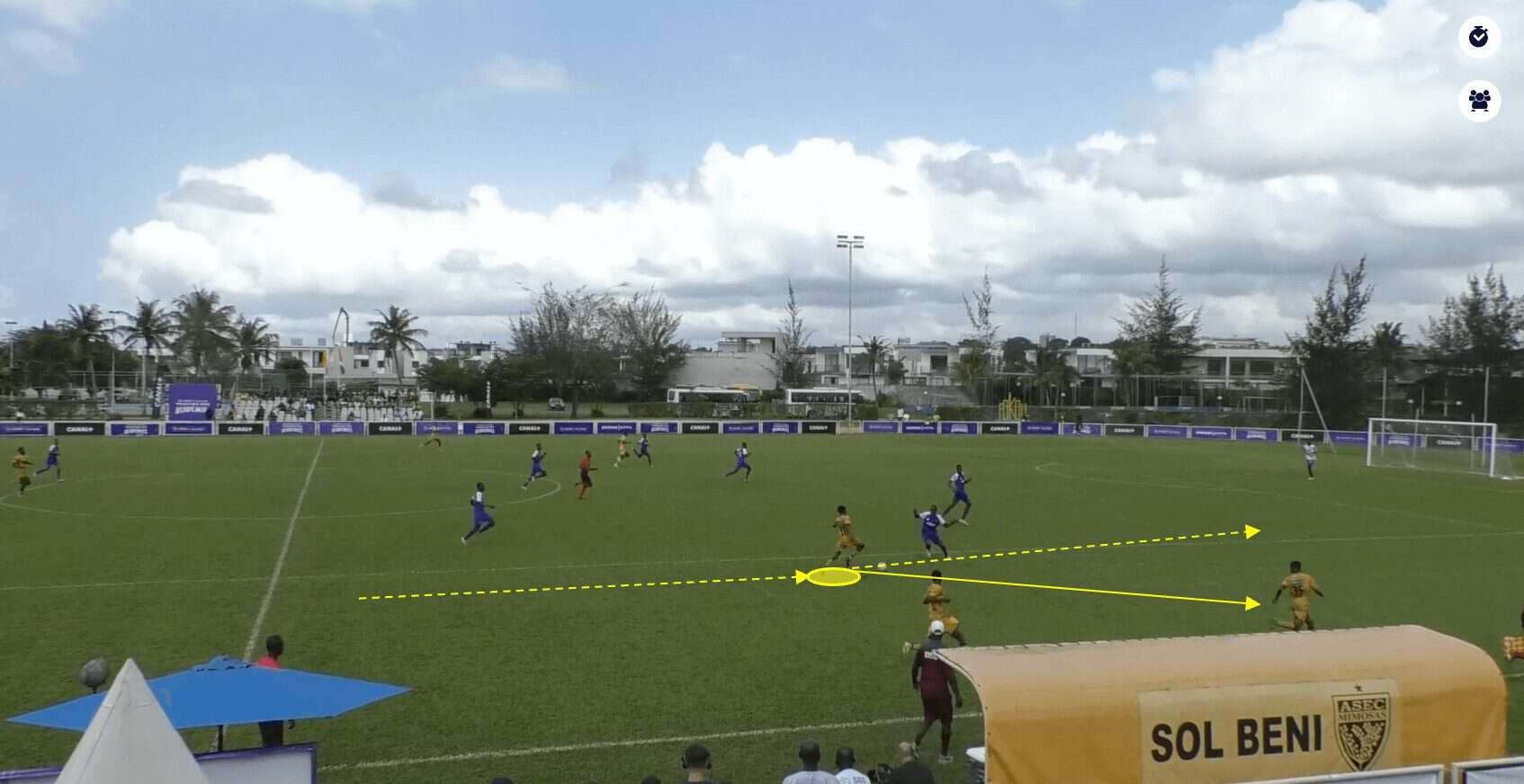
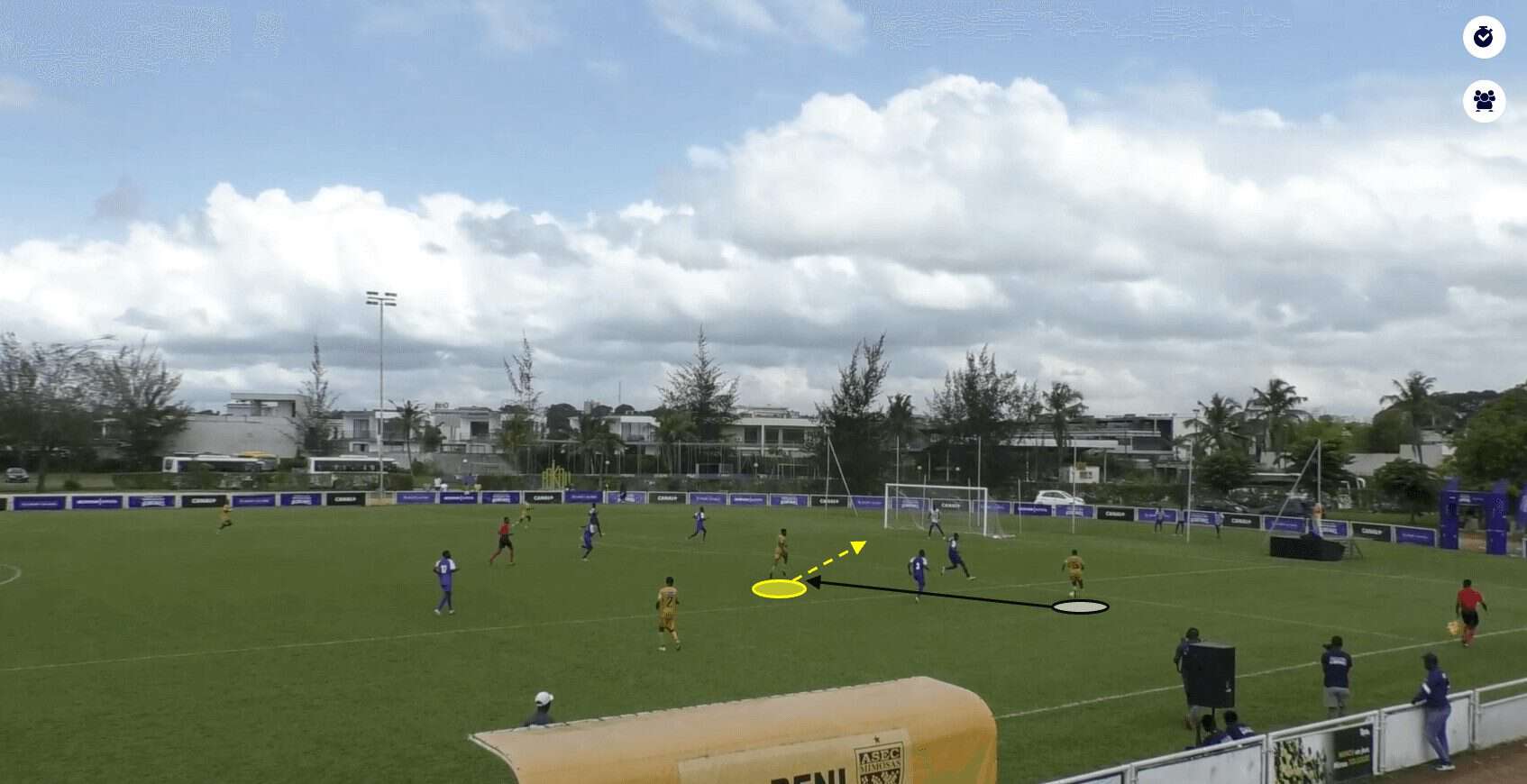
N’Cho carries the ball forward and lays it off to a teammate whilst continuing his run. As the opponents struggle to get back into their defensive shape, spaces open up; therefore, when N’Cho receives the ball back, he can carry it into the area. On this occasion, the Ivorian forward hits a shot on target, which the ‘keeper saves. This is an excellent example of how ASEC Mimosas can utilise N’Cho’s speed and ball-carrying abilities to execute lethal counterattacks.
Regarding what the numbers say, N’Cho averages 3.2 shots per 90, with 2.8 per 90 from inside the penalty area and an average of 1.07 per 90 on target. Plus, he averages 4.1 take-ons per 90, which shows how he likes to utilise his dribbling ability to beat opponents, especially in the transition from defence to attack.
The ASEC Mimosas forward’s ability to carry the ball at pace also contributes to strategic ball retention. Instead of opting for speculative passes, he can advance the ball into more favourable attacking positions, maintaining possession while simultaneously driving the team up the pitch.
Furthermore, N’Cho can attract multiple defenders towards him when in possession; this creates imbalances in the opposition’s defensive setup. This opens up opportunities for the teammates to get into good positions, thereby creating goalscoring chances or exploiting the opposition’s defensive vulnerabilities.
Tidiane Malick Siaka
The next player we want to highlight in this scout report is 19-year-old left-footed winger Tidiane Siaka. He is comfortable playing on either flank, as an inverted winger on the right or an out-and-out winger on the left. Siaka can also play as a central attacking midfielder, providing his team with many options due to his versatility.
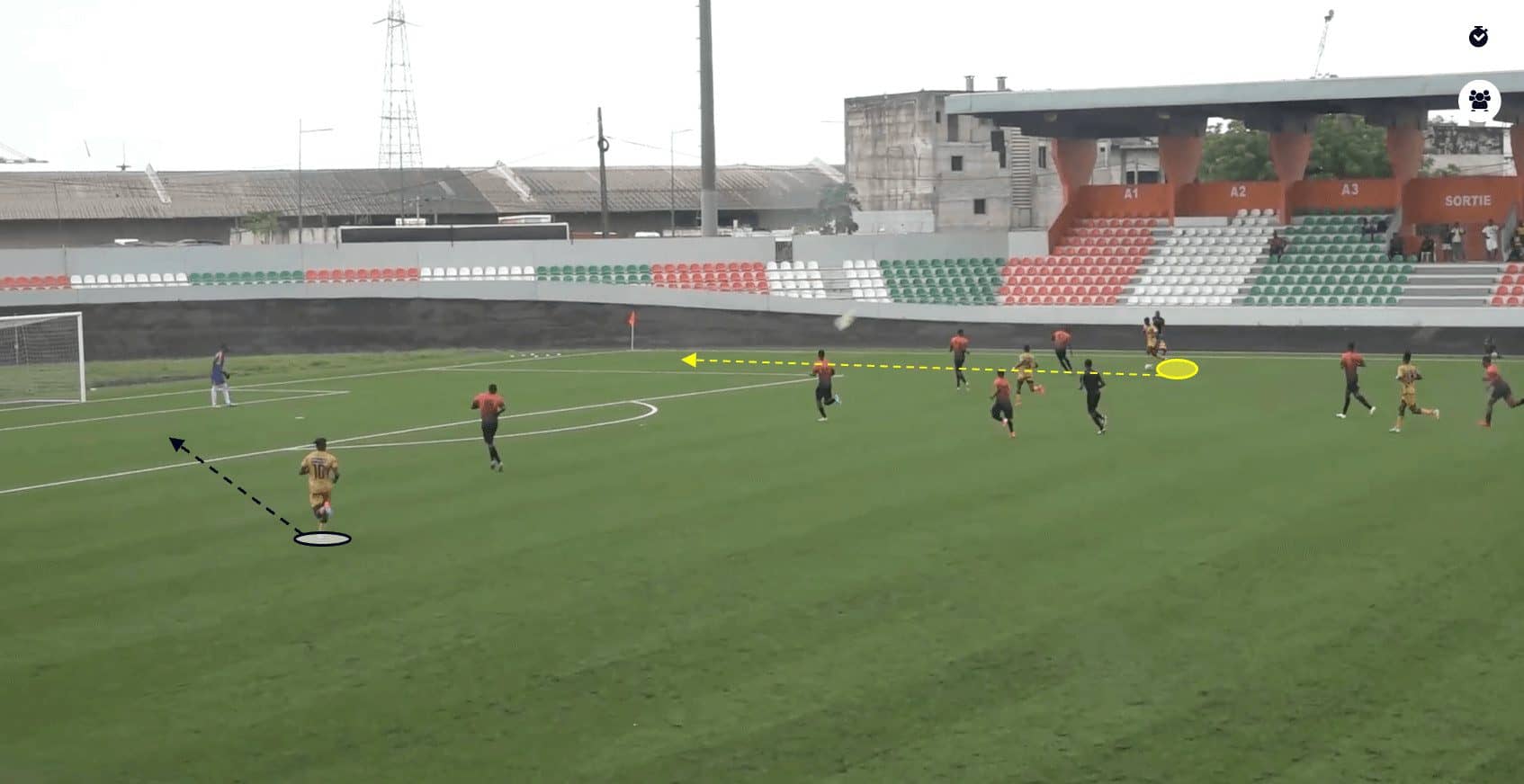
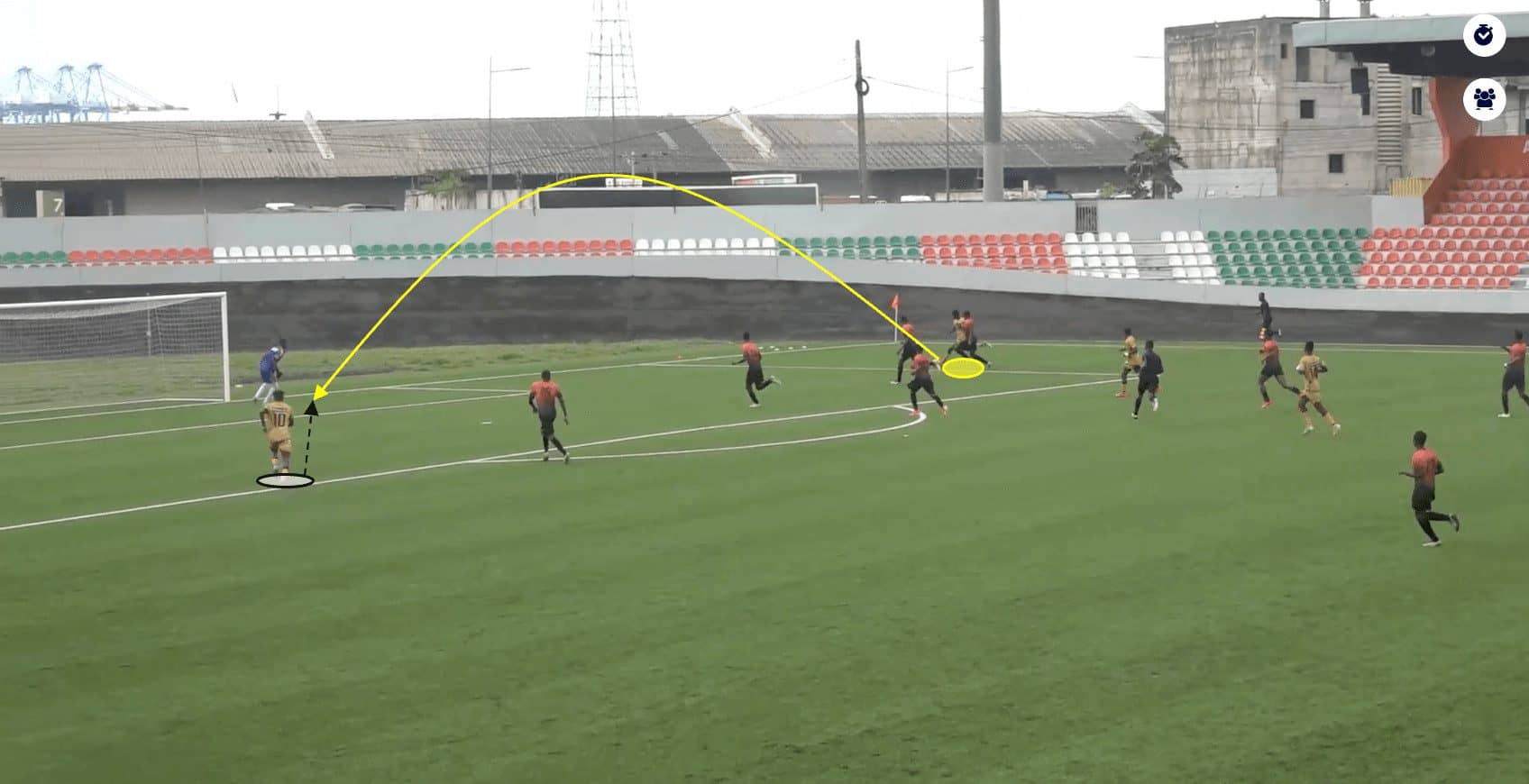
Siaka is a highly dynamic winger who thrives in 1v1 situations. His explosive pace presents a constant threat to opposing defences. Here, he accelerates away from his opponent and gets into an excellent crossing position. Plus, he is very adept at crossing with either foot, making it incredibly difficult for defenders to decide whether to show him inside or down the flank.
With his speed and dribbling skills, the winger can easily bypass defenders, break defensive lines, and create major imbalances in the opposition’s defensive structure. Tidiane Siaka averages 5.1 take-ons per 90 as ASEC Mimosas aim to use his dynamism to their advantage in attack. As we can see, his ability to beat opponents opens up avenues for him to deliver crosses or cut inside for goalscoring opportunities, adding an unpredictable dimension to the team’s offensive approach.
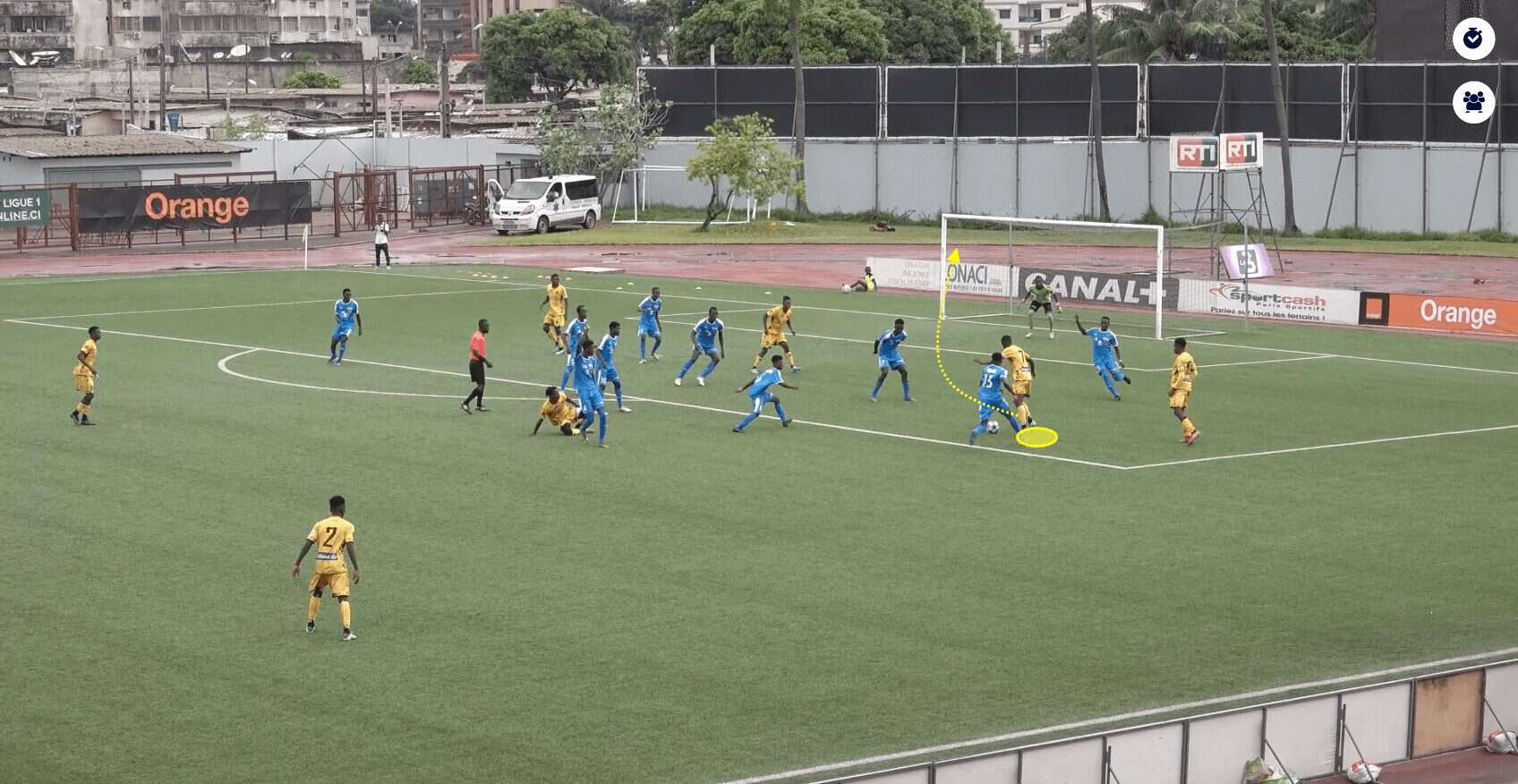
Now, we must acknowledge that Siaka is not the most prolific goalscorer. However, he consistently gets into good positions, which suggests that goals will eventually become part of his game with a bit of work. His speed allows him to quickly move into spaces, consequently, defenders often stand off him due to the fear that if they stick too tightly, there is a high chance of Siaka spinning them.
The winger averages 1.16 shots per 90, but only 0.23 per 90 are on target, which shows that this area of his game requires work. In the example above, Siaka gets into a good position but, unfortunately, executes a weak shot.
Furthermore, Siaka’s ability to exploit pockets of space contributes to ASEC Mimosas’ overall attacking fluidity. The winger becomes a constant outlet for teammates by intelligently positioning himself between defensive lines. This creates passing options for the team but also forces defenders to constantly be aware of his positioning due to his speed and dribbling ability. This increases the likelihood of defenders making errors or spaces becoming available.
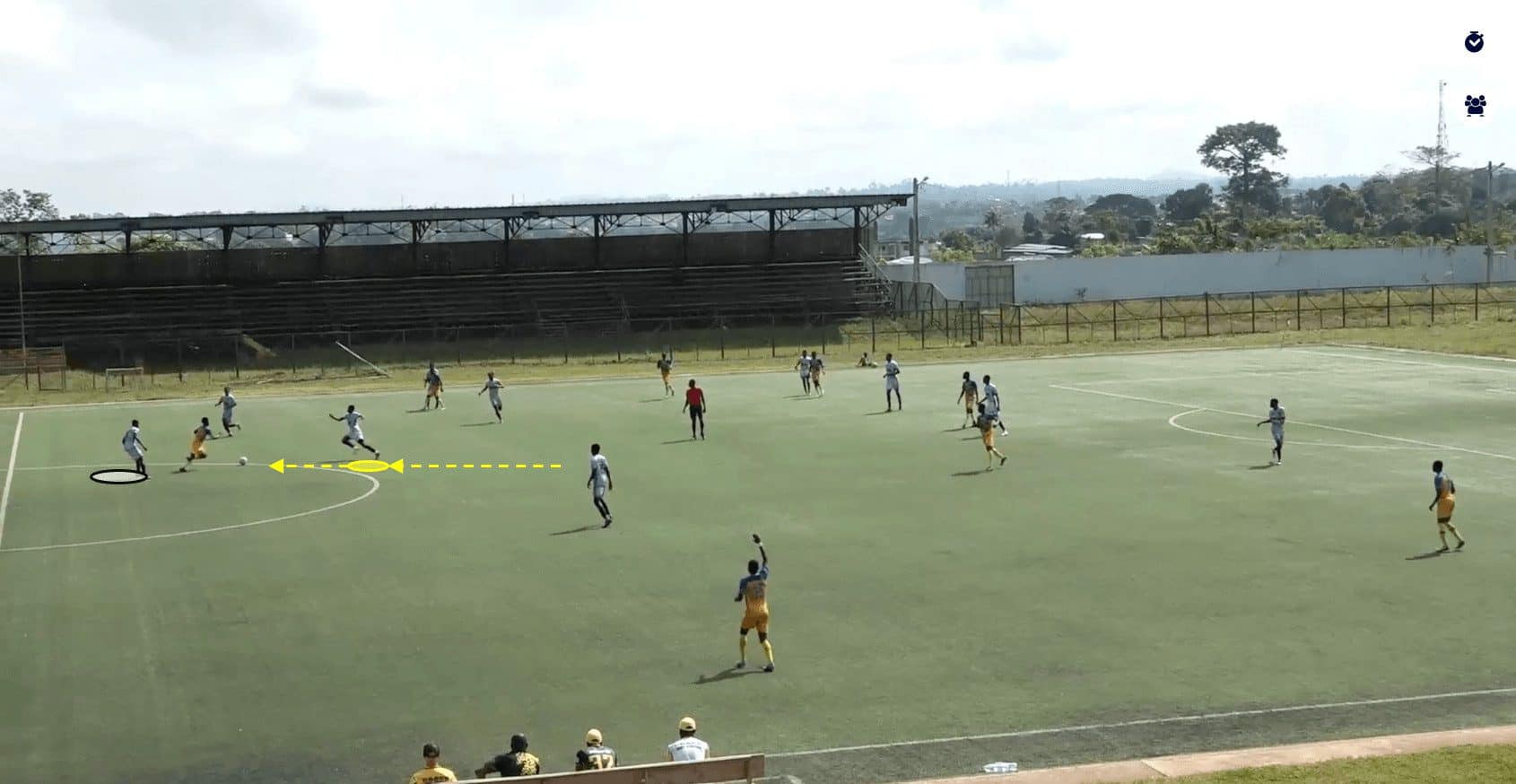
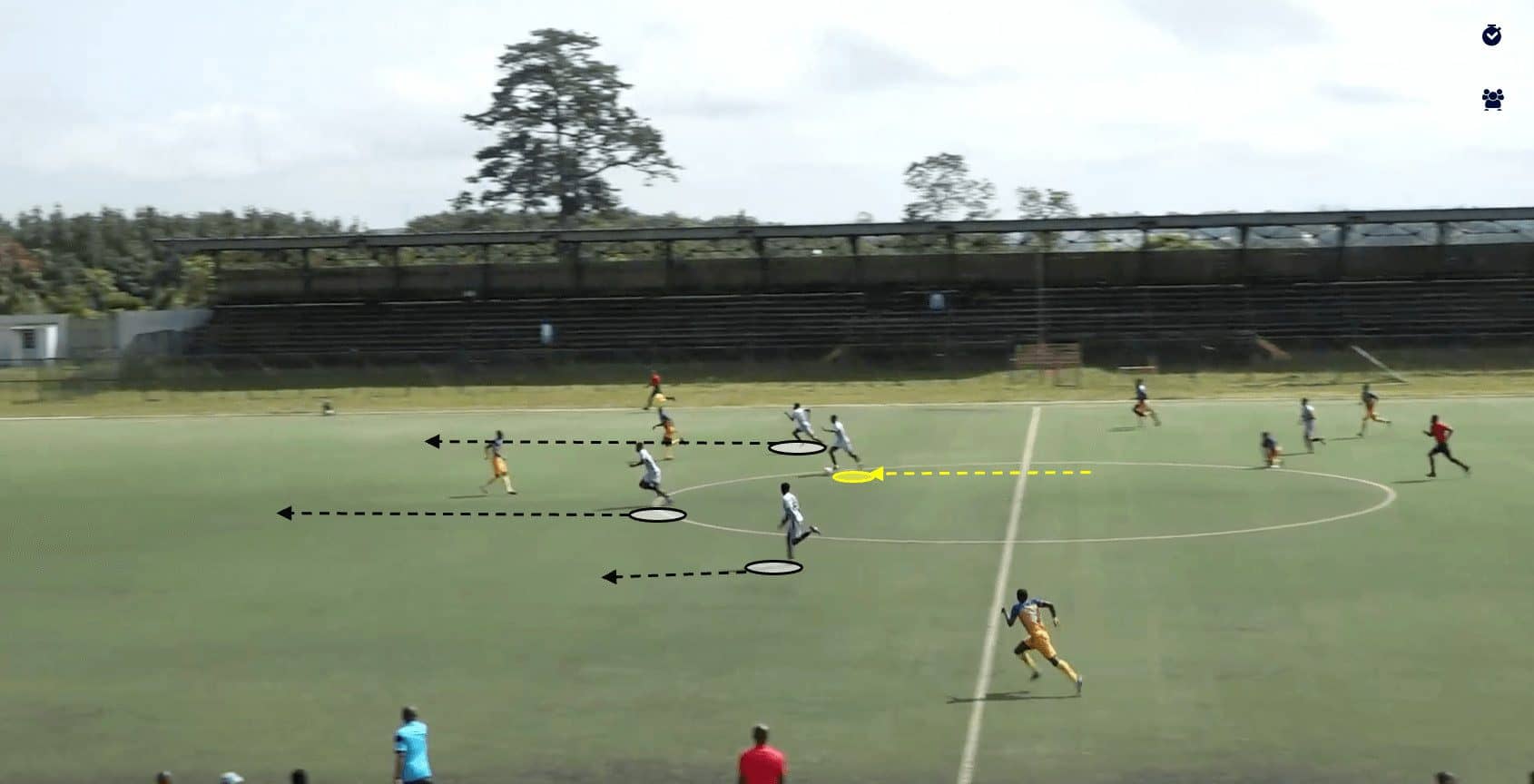
Moreover, Siaka works hard in the defensive phase of play. The 19-year-old executes 4.9 tackles per 90 to aid his team’s cause. The example above shows how he uses a short burst of acceleration to press an opponent. He is incredibly tenacious and physically very strong; he averages 1.16 ground duels per 90 and wins 0.93 per 90.
Upon regaining possession, Siaka utilises his ball-carrying abilities to launch the counterattack. As we can see, he has three teammates making runs ahead of him, and in this scenario, he makes a good pass into the path of the player to his left. Siaka has a useful passing ability; he mostly keeps it simple, playing short passes. However, he always looks to be positive when he has the ball at his feet. He averages 18.5 forward passes per 90, and 1.85 key passes per 90. Siaka’s skills mean that he is a constant threat both in and out of possession.
Conclusion
This scout report has highlighted four players within the ASEC Mimosas youth system that we believe can go on to have a big impact in football. We have seen how Kone is a dominating presence in the midfield and how Kaboré and N’Cho both bring unique skillsets to their attacking play as centre forwards. Additionally, we have highlighted Siaka’s dynamism in the wide areas and shown why he is one to watch.
It has to be said that the Iconic Ivorian club has many talented youngsters within its youth system, and choosing just four players for this scout report was incredibly difficult. The future is certainly very bright for ASEC Mimosas and the Ivory Coast.





Comments